
Euclea, from the Greek eukleia meaning "glory and fame", denotes a group of flowering plants in the Ebenaceae or ebony family. They were described as a genus by Linnaeus in 1774. The genus includes evergreen trees and shrubs, native to Africa, the Comoro Islands and Arabia. Several species are used for timber, producing a hard, dark heartwood timber similar to ebony.

Leucas is a genus of plants in the family Lamiaceae, first described by Robert Brown in 1810. It contains over 200 species, widespread over much of Africa, and southern and eastern Asia with a few species in Queensland and on various islands in the Indian Ocean.
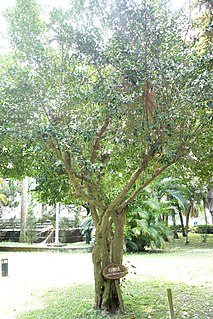
Suregada is a plant genus of the family Euphorbiaceae, first described as a genus in 1803. It is native to tropical and subtropical regions of Africa, the Indian Subcontinent, China, Southeast Asia, Australia, and certain oceanic islands.
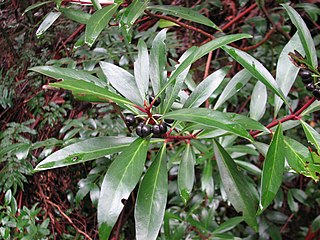
Tasmannia lanceolata, commonly known as Tasmanian pepperberry, mountain pepper (Aus), or Cornish pepper leaf (UK), is a shrub native to woodlands and cool temperate rainforest of south-eastern Australia. The shrub varies from 2 to 10 m high. The aromatic leaves are lanceolate to narrow-elliptic or oblanceolate, 4–12 cm long, and 0.7–2.0 cm wide, with a distinctly pale undersurface. Stems are quite red in colour. The small cream or white flowers appear in summer and are followed by black, globose, two-lobed berries 5–8 mm wide, which appear in autumn. There are separate male and female plants.

Microseris lanceolata is an Australian alpine herb with yellow flowers and one of three plants known as murnong or yam daisy along with Microseris scapigera and Microseris walteri.
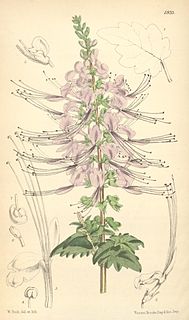
Orthosiphon is a genus of plants in the family Lamiaceae native to Africa, Southern Asia and Queensland, with one species (O. americanus) in Colombia. They are herbaceous shrubs which grow to a height of 1.5 m (5 ft). Some Orthosiphon species are popular garden plants because of their flowers, which are white and bluish with filaments resembling a cat's whiskers. In the wild, the plants can be seen growing in forests and along roadsides.

Coleus caninus, synonym Plectranthus caninus, is a herb from the mint family Lamiaceae, native to southern and eastern Africa from Angola to Sudan and to India and Myanmar.

Turraea is a genus of plants in the family Meliaceae, native throughout of Old World Tropics.

Melaleuca lanceolata commonly known as black paperbark, moonah, Rottnest Island teatree and western black tea tree is a plant in the myrtle family, Myrtaceae and is native to Australia where it occurs in Western Australia, South Australia, Victoria, New South Wales and Queensland. It is a densely foliaged tree with rough bark, which flowers prolifically in summer.

Persoonia lanceolata, commonly known as lance-leaf geebung, is a shrub native to New South Wales in eastern Australia. It reaches 3 m (10 ft) in height and has smooth grey bark and bright green foliage. Its small yellow flowers grow on racemes and appear in the austral summer and autumn, followed by green fleshy fruits which ripen the following spring. Within the genus Persoonia, P. lanceolata belongs to the lanceolata group of 58 closely related species. It interbreeds with several other species found in its range.
Robert Louis August Maximilian Gürke was a German botanist. He usually appears in the literature as Max Gürke..

Persoonia glaucescens, commonly known as the Mittagong geebung, is a species of flowering plant in the family Proteaceae and is endemic to New South Wales. It is an erect shrub with smooth bark, hairy young branchlets, lance-shaped leaves with the narrower end towards the base, and yellow flowers. It is the only persoonia in eastern Australia with strongly glaucous leaves.

Ottelia is a genus of an aquatic plant family Hydrocharitaceae described as a genus in 1805. The genus is native to tropical and subtropical regions of Africa, Asia, South America, and Australia.
Isonandra lanceolata is a plant in the family Sapotaceae. The specific epithet lanceolata means "spear-shaped", referring to the leaves.

Tinnea is a genus of plants in the family Lamiaceae first described in 1867. It is native to sub-Saharan Africa.
- Tinnea aethiopicaKotschy ex Hook.f. - widespread from Mali to Somalia south to Mozambique; naturalized in Trinidad & Tobago
- Tinnea antiscorbuticaWelw. - Zaïre, Zambia, Angola
- Tinnea apiculataRobyns & Lebrun - eastern Africa from Rwanda to Mozambique
- Tinnea barbataVollesen - Swaziland, northern South Africa
- Tinnea barteriGürke - western Africa
- Tinnea benguellensisGürke - Angola
- Tinnea coeruleaGürke - Zaïre, Zambia, Angola
- Tinnea eriocalyxWelw. - Zaïre, Angola, Botswana, Namibia
- Tinnea galpiniiBriq. - Mozambique, Swaziland, South Africa
- Tinnea gossweileriRobyns & Lebrun - Angola
- Tinnea gracilisGürke - Tanzania to Zambia
- Tinnea mirabilis(Bullock) Vollesen - Tanzania
- Tinnea physalisE.A.Bruce - Tanzania
- Tinnea platyphyllaBriq. - Zaïre
- Tinnea rhodesianaS.Moore - South Africa, Namibia, Zimbabwe, Zambia, Angola, Mozambique
- Tinnea somalensisGürke ex Chiov. - Ethiopia
- Tinnea vesiculosaGürke - Tanzania, Malawi
- Tinnea vestitaBaker - Zimbabwe, Zambia, Angola, Botswana
- Tinnea zambesiacaBaker - Zimbabwe, Zambia, Malawi, Mozambique
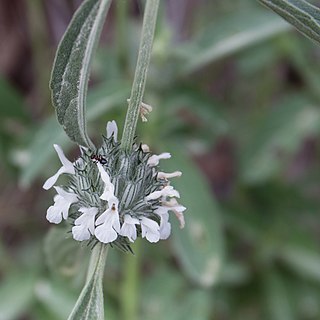
Acrotome is a genus of plants in the family Lamiaceae, first described in 1838. The genus is native to the southern part of Africa.
Fuerstia is a genus of plants in the family Lamiaceae, first described in 1929. It is native to eastern and southern Africa.
- Fuerstia adpressaA.J.Paton - Angola
- Fuerstia africanaT.C.E.Fr. - East Africa
- Fuerstia angustifoliaG.Taylor - Tanzania, Angola, Malawi, Zambia
- Fuerstia bartsioides(Baker) G.Taylor - South Sudan
- Fuerstia dendrothrixA.J.Paton - Somalia
- Fuerstia raraG.Taylor - Angola
- Fuerstia rigida(Benth.) A.J.Paton - Angola
- Fuerstia ternataA.J.Paton - Tanzania
- Fuerstia welwitschiiG.Taylor - Angola

Pycnostachys is a genus of plants in the family Lamiaceae, first described in 1826. It is native to sub-Saharan Africa including Madagascar.
- Pycnostachys abyssinicaFresen. - Ethiopia
- Pycnostachys angolensisG.Taylor - Angola
- Pycnostachys batesiiBaker - Cameroon, Zaïre, Sudan, Uganda
- Pycnostachys chevalieriBriq. - Central African Republic
- Pycnostachys ciliataBramley - Tanzania, Malawi, Mozambique, Zambia
- Pycnostachys coeruleaHook. - East Africa from Ethiopia to Botswana; Madagascar
- Pycnostachys congensisGürke - Zaïre, Zambia
- Pycnostachys de-wildemanianaRobyns & Lebrun - East Africa from Burundi to Zimbabwe
- Pycnostachys deflexifoliaBaker - Kenya, Tanzania, Uganda
- Pycnostachys descampsiiBriq. - Zaïre
- Pycnostachys elliotiiS.Moore - Zaïre, Uganda
- Pycnostachys eminiiGürke - from Cameroon to Ethiopia + Tanzania
- Pycnostachys erici-roseniiR.E.Fr - Zaïre, Uganda, Burundi, Rwanda
- Pycnostachys goetzeniiGürke - Zaïre, Uganda, Rwanda
- Pycnostachys gracilisR.D.Good - Angola
- Pycnostachys graminifoliaPerkins - Tanzania
- Pycnostachys kassneriDe Wild - Zaïre, Zambia, Tanzania
- Pycnostachys lancifoliaBramley - Tanzania
- Pycnostachys meyeriGürke - western + central Africa
- Pycnostachys nepetifoliaBaker - Kenya
- Pycnostachys niamniamensisGürke - South Sudan, Kenya, Uganda
- Pycnostachys orthodontaGürke - Zimbabwe, Mozambique, Zambia, Tanzania
- Pycnostachys parvifoliaBaker - Zambia, Tanzania, Malawi
- Pycnostachys prittwitziiPerkins - Zambia, Tanzania
- Pycnostachys pseudospeciosaBuscal. & Muschl. - Zaïre, Zambia
- Pycnostachys recurvataRyding - Ethiopia
- Pycnostachys reticulata(E.Mey.) Benth. - central + southern Africa
- Pycnostachys ruandensisDe Wild. - east-central Africa
- Pycnostachys schliebeniiMildbr. - east-central Africa
- Pycnostachys schweinfurthiiBriq - western + central Africa
- Pycnostachys speciosaGürke - Kenya, Uganda, Tanzania, Rwanda
- Pycnostachys sphaerocephalaBaker - Zambia, Tanzania, Malawi, Zaïre
- Pycnostachys stuhlmanniiGürke - central Africa
- Pycnostachys umbrosa(Vatke) Perkins - Kenya, Tanzania
- Pycnostachys urticifoliaHook. - southeastern Africa
- Pycnostachys verticillataBaker - Zambia, Tanzania
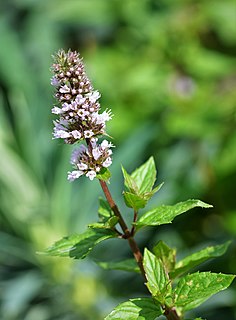
Nepetoideae is a subfamily of plants in the family Lamiaceae.

Cienfuegosia is a genus of plants, in the family Malvaceae and placed in the tribe Gossypieae. Species can be found in central and south America, Africa including the Arabian peninsula.
















